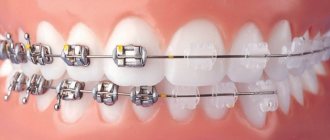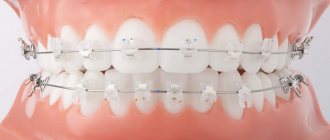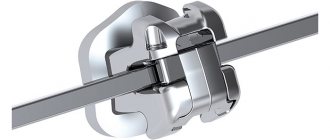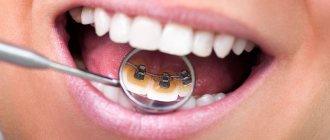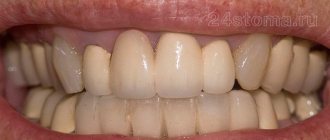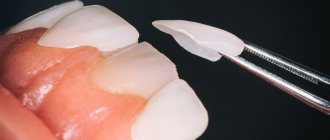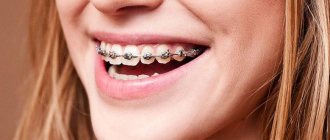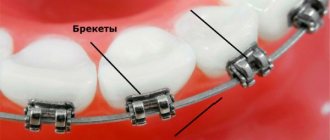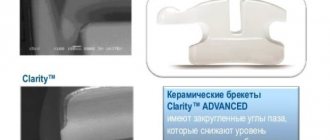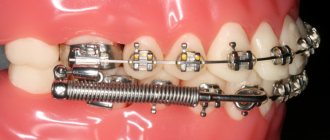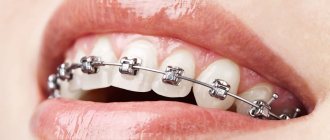Modern dentistry offers many effective ways to treat dental defects. For example, self-ligating braces. These are innovative designs that allow you to quickly and comfortably correct malocclusion. Self-ligating braces differ from classic braces in the way they are attached. The design does not have locks, and the tension arc slides freely in the grooves.
The price of installing non-ligature braces in Moscow depends on the material of manufacture, the manufacturer’s company, and the cost of the orthodontist’s work. Metal structures are cheaper than ceramic ones. The treatment period does not differ from classical options, since teeth are straightened under the influence of an arch.
The principle of operation of self-ligating non-ligature braces
The non-ligature design consists of a base and a tightening wire.
The base is the bracket itself, made in the form of a rectangular plate. The bracket is attached to the tooth using glue, and its surface has a relief texture for strong fixation. Micro-locks are installed on the outer side of the self-ligating bracket system. They are grooves with closing lids. An arc is inserted into the lock. It is the wire that creates the desired dental effect, directing the growth of teeth to the correct position. The arc has a memory effect and tends to return to its original position. Thanks to this effect, the teeth are straightened.
When treated with braces, you may feel stress on your jaws. The arcs of self-ligating braces slide freely in the grooves. Therefore, patients experience virtually no discomfort in the oral cavity, since the pressure on the dentition is less than with classical treatment methods.
From a dental expert
Please note that this type of dental appliance is not suitable for treating complex problems. Severe defects are treated with ligature braces, which place high pressure on the jaw.
Indications and contraindications for use
Correction of dental anomalies using braces is a medical procedure, and therefore is performed only for certain indications. Let's look at what problems can be solved using ceramic bracket systems:
- mild to moderate malocclusion (congenital or acquired);
- crowding of dental elements;
- diastema or trema;
- dystopia (improper position of the tooth).
For patients' information: when treating severe pathologies of occlusion, orthodontists advise choosing metal brace systems. The fact is that in such cases, significant pressure must be applied for correction, and the ceramic plates may simply not withstand it and crack.
Corrective therapy using braces cannot be performed in the following cases:
- during the period of milk or mixed dentition;
- during pregnancy and breastfeeding. This period is not an absolute contraindication, but orthodontists recommend not correcting the bite during this time;
- for inflammatory diseases of the oral mucosa;
- in case of caries, pulpitis and other problems;
- for oncology, tuberculosis, AIDS;
- with implanted dental implants.
Types of self-ligating braces
Depending on the method of fastening, non-ligature braces are divided into:
1. Vestibular . The bracket is glued to the outside of the teeth with glue. This is the most popular method of fixation, however, it has a drawback - the design is noticeable when a person smiles or talks.
2. Lingual . Such braces are fixed on the inside of the row. Therefore, they are invisible to others and have a high level of aesthetics. The structures are made individually, since the braces must follow the anatomy of the inner part of the dentition. Therefore, the price of lingual systems is higher than that of vestibular ones. In addition, if the tooth height is insufficient, it is impossible to secure the structure.
Self-ligating bracket systems differ in materials of manufacture:
1. Metal . They are characterized by low cost but high strength. They effectively correct defects using high pressure on the jaw, maintain appearance and do not stain the enamel. But there are also disadvantages - metal braces are noticeable to others and in rare cases can cause allergic reactions in the oral cavity.
2. Ceramic . The bases are made to match the natural color of the enamel. Ceramic bracket systems are smaller than metal ones and have a high level of aesthetics. They are not noticeable to others and are not stained by food. Despite the advantages of ceramic structures, they are inferior to metal in terms of reliability.
3. Sapphire . These are partially ceramic systems. They are made from an artificial sapphire crystal that is grown in laboratories. They have a transparent texture and shimmer beautifully in the sun. However, the cost of installing sapphire structures is three times higher than metal ones. In addition, sapphire does not withstand high loads and is not suitable for treating complex problems.
Reasons for the need to correct malocclusion
The attractiveness of teeth is not always important for a person. Many people choose to smile less or turn away while talking rather than get their bite problems treated. But they can lead to more serious problems.
It is very important to correct the unnatural arrangement of teeth in a timely manner, especially when they interfere with the correct functioning of the jaws.
If you ignore the problem, you can provoke the following troubles:
- Disturbance of the digestive system due to poor quality of chewing food.
- Loss of dental organs caused by uneven load on them. It happens that some teeth are not exposed to stress, while others are subject to double the load.
- Inflammation of the mandibular joints.
- There is an increased risk of caries in places where food constantly gets stuck due to unevenness of the organs.
- Teeth erupting above or below the desired location.
Advantages of self-ligating braces
Among the positive aspects of installing self-ligating braces are:
- Low level of trauma when correcting bites. The tension wire does not put pressure on the dentition in such a way as to cause pain and discomfort.
- Reducing the treatment period. Using traditional methods you will spend 30% more time.
- There is no need to adjust braces frequently. Due to the absence of ligatures, patients visit the doctor once every three months.
- Self-ligating braces are easier to maintain.
- No ligatures that rub delicate areas of the oral cavity. The risk of irritation is reduced to almost zero.
Differences
Discarding advertising myths, we can highlight the main differences between ligature and non-ligature braces:
- Arc fixation method.
Some have ligatures, others have micro-locks.
- Size.
Ligatures are flatter, self-ligating, about 1 mm thicker due to built-in locks. In the first place, some discomfort is created by the ligatures, and in the second place, by the massive braces themselves.
- Efficiency.
Ligatures cope with the most complex anomalies, self-ligating simpler clinical cases.
- Correction.
Replacing rubber bands and wires and correcting the position of the arch of ligature braces takes longer. Patients with self-ligating appliances spend less time in the orthodontic chair.
- Care.
It is more difficult to care for ligatures; elastic bands and wires increase the time of hygiene procedures.
- Price.
Designs with micro-locks are two to three times more expensive.
How to install self-ligating braces
The process of fixing a self-ligating bracket system takes place in several stages:
1. Preparatory . At this stage, the orthodontist collects anamnesis, analyzes the clinical situation and selects a treatment method. Before installing braces, be sure to cure caries and clean the surface of the dentition from stone deposits and plaque. Then, an impression of the teeth is taken to make a self-ligating structure.
2. Fixing the locks . At this stage, the dentist glues micro-locks to the surface of the tooth with a special compound. Be sure to remove any remaining glue.
3. Fixation of the arc . The wire is inserted into the grooves of the bracket and closed with a lid.
The whole procedure takes no more than an hour and a half. At the same time, patients rarely experience pain.
Comparative characteristics
| Characteristics | Ligature braces | Self-ligating braces |
| Arc fixation method | Ligatures | Micro locks |
| Attaching braces | To the vestibular and lingual surfaces of the teeth | To the vestibular and lingual surfaces of the teeth |
| Materials | Metal, ceramics, sapphire | Metal, ceramics, sapphire |
| Correction frequency | Once a month | Manufacturers recommend once every 2-3 months |
| Painfulness of treatment | Individually | Individually |
| Duration of treatment | From 14 months to 3.5 years | According to the manufacturers - 20-30% shorter |
| Treatment effectiveness | Corrects the most complex malocclusions | Cannot cope with complex malocclusions |
| The need to remove teeth before installing the device | If the jaw is small and there is no room for 32 straight teeth, removal is inevitable. | If the jaw is small and there is no room for 32 straight teeth, removal is inevitable. |
| Price | From 9000 rubles | From 25,000 rubles |
Duration of treatment with self-ligating braces
From a dental expert
The average duration of wearing self-ligating braces is one and a half to two years.
It is worth noting that in childhood and adolescence, treatment time is reduced by about six months. This is due to the fact that in children the skeletal system has not had time to fully form. In some situations, healthy teeth may need to be removed to expand the row. Finally, the duration of treatment with a self-ligating construct depends on the severity of the problem and the individual characteristics of the patient.
Reviews
Anna, 34 years old
I straightened my teeth at 31. We had ligature-free braces “Damon Clear”. I wore the designs for 1.5 years. During this time, we managed to achieve the desired result - a beautiful smile. The treatment process was not something supernatural or difficult for me. Due to their low visibility, these braces did not attract much attention from others. I also quickly got used to the peculiarities of cleaning teeth with braces.
Rinat, 25 years old
Since adolescence, I had complexes about the curvature of my front teeth. My parents suggested braces more than once, but I dismissed the idea because I imagined that I would become the object of increased negative attention from my peers. But I decided to straighten my teeth when I was already 22 years old. I met a girl, and she once told me that she was fine with braces, and that if I walked around with them, it wouldn’t bother her at all. She went with me to the clinic, they chose non-ligature braces. Fortunately, I got used to them quickly. The only thing that bothered me a little was the need for increased hygiene. At the end of the treatment I received a beautiful smile. I don’t understand why I didn’t install them earlier when my parents suggested, I would have lived a normal life long ago. But apparently everything has its time.
Victoria, 17 years old
I got ligature-free braces 4 days ago. It didn't hurt at all. But I still can’t get used to them properly. It seems like it's constantly stirring in my mouth. The doctor says that this is normal and that everything will pass soon. The appearance doesn't bother me at all. It’s even cool to walk around with such decoration.
How to care for self-ligating braces
As already mentioned, non-ligation braces are easier to maintain. To avoid problems, follow the rules:
- Use medium-hard brushes to brush your teeth.
- Clean out leftover food with dental floss to prevent tooth decay.
- Use special brushes to clean braces.
- Use mouthwash after eating food.
It is worth noting that after installing braces, you should reconsider your diet. It is advisable to exclude solid foods and viscous products.
Self-ligating braces are a great way to get rid of defects in the oral cavity, gain a healthy smile and self-confidence. Our clinic in Moscow offers the best price for self-ligating braces, see for yourself, come for a free consultation and we will choose the best option for you.
Popular brands
Our clinics use only the most effective ligature and non-ligature brace systems, which have received a positive recommendation from specialists and patients. Here are some of them:
- metal ligatures Victory, Biomim;
- ceramic ligatures Advanced, Hype;
- self-ligating metal DamonQ, H4;
- self-ligating ceramic Damon Clear;
- self-ligating lingual WIN and INCOGNITO.
The network of Moscow aesthetic dentistry centers “Smile” offers reasonable prices for orthodontic therapy, the opportunity to pay for braces in installments and without interest, and a family discount. Our specialists have higher basic education and regularly improve their professional level by undergoing training in leading Russian and European orthodontic clinics. We provide our patients with treatment that meets international standards.
Our branches are located within convenient transport accessibility:
- in the district of Art. m. Alekseevskaya (VDNH district and Mira Ave.), st. 3rd Mytishchinskaya 3, building 2;
- in the district of Art. m. Shelepikha, Shelepikhinskaya embankment, 34, building 1.
Our orthodontists will make your smile beautiful! We are waiting for you!
